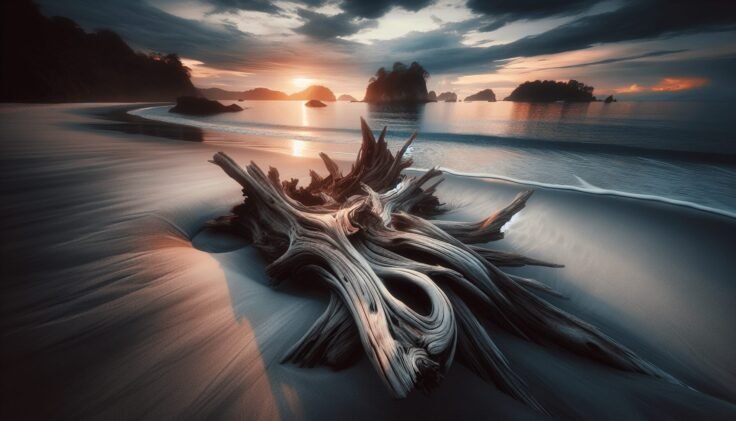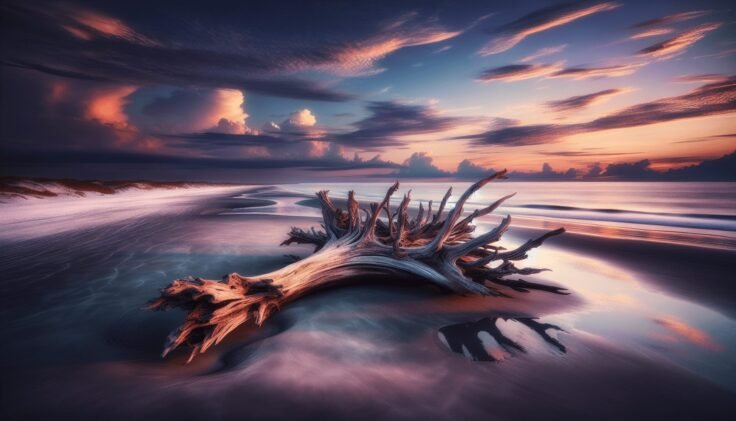Have you ever stood on a beach where nature itself seems to have become an artist, shaping and rearranging earth’s elements in a masterpiece? Driftwood Beach on Jekyll Island is just such a place, where gnarled and twisted driftwood litters the sandy shore, creating an ethereal and breathtaking landscape that’s perfect for photography. This enchanting location offers unique photographic opportunities that you won’t find anywhere else. Let’s unravel the secrets of this photogenic paradise, whether you’re a seasoned photographer or just someone who loves capturing memories on your smartphone.
What Makes Driftwood Beach Unique?
Driftwood Beach is not your typical sandy shoreline. The beach gets its name from the pieces of driftwood scattered artfully across its sands, resembling natural sculptures left behind by the sea. Weathered by time and tide, these formidable tree trunks and branches create a haunting yet captivating environment that invites exploration and creativity.
The History Behind Driftwood Accumulation
Understanding the history of how Driftwood Beach formed adds an intriguing layer to your photographic experience. The driftwood is the result of decades of erosion, caused by ocean currents and storms that have slowly taken their toll on the northern tip of Jekyll Island. Over time, trees were uprooted by the shifting sands and encroaching sea, leaving behind an array of beautiful, skeletal remains. This evolution provides not just a visually stunning scene but also a testament to the power of nature.
Natural Setting Enhancements
In addition to the driftwood, the natural beauty of this location extends to its vibrant sunsets and wide-open skies, which are perfect backdrops for striking photographs. The beach’s remote feel is another element that enhances its uniqueness, offering an unobstructed view of both the land and the seascape. With few artificial lights, it’s also an ideal location for night photography, capturing stars against the unusual terrain.
Best Times to Photograph Driftwood Beach
Photographers often speak of the “golden hour,” those precious periods just after sunrise and right before sunset when the sunlight is softer and creates long shadows and warm tones. These times can bring the weathered textures of the driftwood to life in your photos. However, different times of day offer their own unique photographic advantages.
Sunrise and Sunset
Sunrise and sunset offer dramatic lighting conditions that can turn Driftwood Beach into a painter’s palette of colors. Dawn provides a serene atmosphere with fewer crowds, allowing you to capture the first light illuminating the driftwood sculptures. Sunset, on the other hand, often casts a warm, golden glow over the entire beach, emphasizing texture and details in your shots.
Midday Photography
While many avoid shooting during midday due to the harsh lighting, this can be an excellent time to focus on capturing the intricate details of the driftwood itself. Bright sunlight can highlight the grooves and patterns carved into the wood by the elements, emphasizing their complex forms.
Night Photography
With very little light pollution, night photography can be particularly rewarding at Driftwood Beach. Long exposure shots can capture star trails, or even the mysterious ambiance of moonlit nights. The shadows and shapes of the driftwood can create otherworldly scenes, making for a truly unique composition.

Essential Photography Tips for Driftwood Beach
Whether you’re an amateur shutterbug or a professional photographer, having some tips up your sleeve can help make your Driftwood Beach experience more rewarding. Each setting comes with its own challenges and opportunities for creativity.
Camera Equipment Essentials
A good camera is the heart of any successful photography session. While your smartphone can certainly capture beautiful images, a DSLR or mirrorless camera with interchangeable lenses will provide more flexibility and control over your shots.
- Wide-Angle Lens: Ideal for capturing expansive shots of the beach’s unique landscape.
- Telephoto Lens: Great for detailed, close-up shots of the driftwood.
- Tripod: Useful for low-light or long-exposure photography, ensuring stability for sharper images.
- Polarizing Filter: Helps reduce glare from water and enhances the sky’s colors.
Composition Techniques
Skillful composition can turn even the simplest shots into masterpieces. Here are some thought-starters:
- Leading Lines: Use the natural lines of the driftwood to guide the viewer’s eye through the image.
- Rule of Thirds: Position your subject along the intersections of the grid lines to create balanced and engaging compositions.
- Perspective: Change your angle by crouching low or finding higher ground to introduce different viewpoints.
- Framing: Use the pieces of driftwood themselves to create natural frames around your focal point.
Capturing Mood and Atmosphere
Photography is not just about capturing an image but also about conveying a feeling or mood. Consider the following:
- Use soft focus or low aperture settings to blur the background and focus attention on your subject.
- Play with black and white settings to emphasize the stark contrast and textures.
- Capture reflection on wet sand for added depth in your composition.
Practical Considerations During Your Visit
Photography is not the only activity that makes Driftwood Beach an intriguing visit. There are logistical considerations to enhance your overall experience on this dynamic natural site.
Access and Directions
Driftwood Beach is located on the northern end of Jekyll Island and is easiest to access by car. Jekyll Island itself is part of Georgia’s Golden Isles and is connected to the mainland by the Jekyll Island Causeway. Parking is available near designated beach access points, followed by a short walk to the shore.
Weather and Tide Factors
Always keep an eye on the weather and tide conditions to plan your photography session effectively. Note that tides can significantly alter the landscape by covering or revealing parts of the driftwood. Low tide may give you more ground to walk on and explore, while high tide can introduce dramatic water scenes.
Safety Tips
Although Driftwood Beach is captivating, stay aware of your surroundings. The weathered wood can be slippery, and loose sand near the water’s edge might cause unexpected footing challenges. Always prioritize your safety, especially during dynamic weather conditions.

Enhancing Your Photographic Journey
Beyond the stunning visuals of Driftwood Beach itself, there are additional ways you can enhance your photography experience and become an even more skilled photographer.
Post-Processing Ideas
After capturing your images, use photo editing software to enhance their beauty. Consider adjusting the following:
- Contrast and Brightness: Enhance the wood’s textures by increasing contrast.
- Color Balance: Adjust to highlight the natural colors of the wood, ocean, and sky.
- Crop and Align: Refine your composition by cropping and leveling the horizon.
Sharing and Community
Share your work with online photography forums or social media to gather feedback and engage with fellow photographers. You’ll find a community who are as passionate as you are about capturing and sharing the beauty of nature.
Return Visits: Nature’s Ever-Changing Canvas
Given that Driftwood Beach is continually evolving due to natural forces, each visit offers a new experience and fresh photographic opportunities. This encourages multiple trips at different times and conditions to build a comprehensive photo collection.
In conclusion, Driftwood Beach on Jekyll Island offers a rare confluence of striking natural beauty and ever-changing elements that make it an exceptional location for photography. By understanding and embracing its unique characteristics, timing your visits, preparing adequately, and employing creative techniques, you can capture the essence of this extraordinary shoreline in your images. Stay inspired and keep experimenting, because photography is as much about enjoying the process as it is about the final image. Happy shooting!